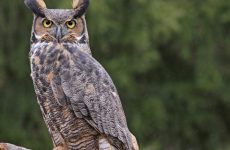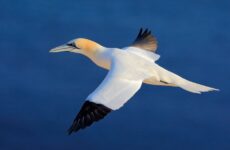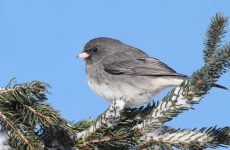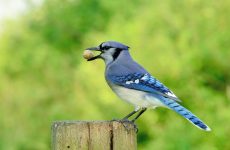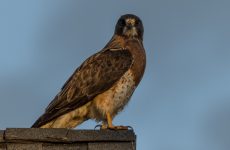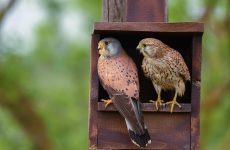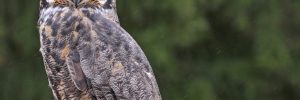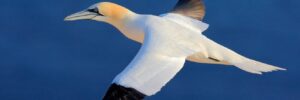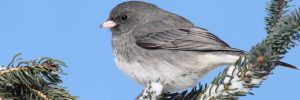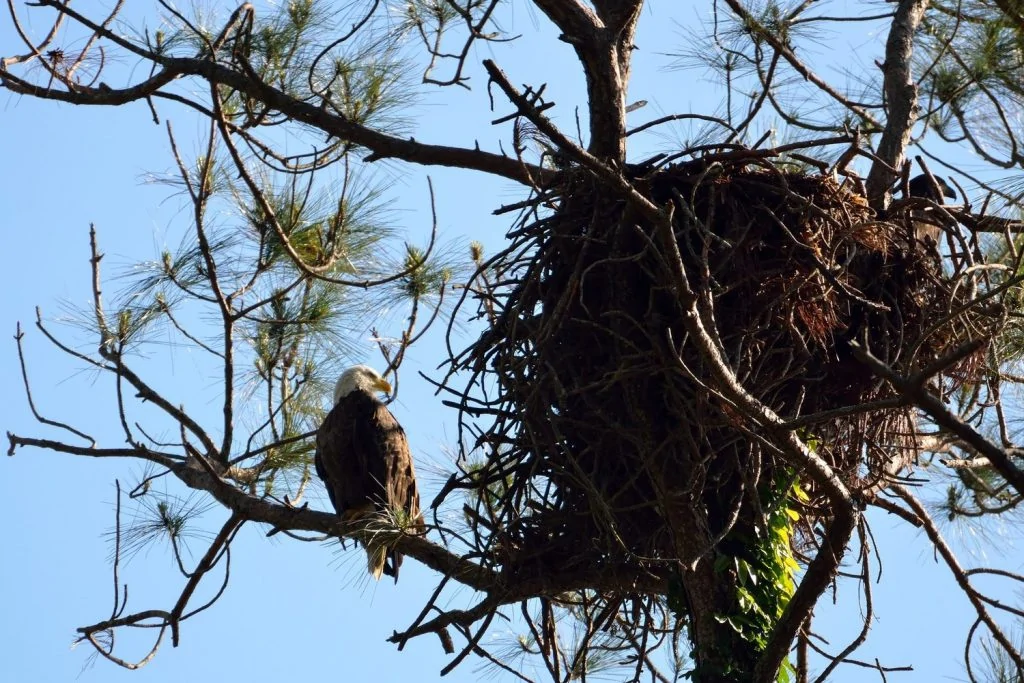
Three of the four species of eagle found in North America have been spotted in Nova Scotia. They are the Bald Eagle, Golden Eagle, and Steller’s Sea-Eagle. However, the Steller’s Sea-Eagle is rare or accidental in Nova Scotia and is not spotted very often.
Eagles are iconic ‘king of the skies’ due to their size and power, and they have had a strong relationship with humans both mentally and physically.
Humans revere eagles and their might and have used them as symbols of power and strength. We have also used them to help with hunting.
However, we have also not been so kind and have persecuted them and destroyed their habitats to the point of almost extinction for many species.
Eagles can carry up to four times their body weight.
There are 60 species of eagles in the world, and they are some of the largest birds. Females are usually larger than males.
If you are interested in birds of prey, you should check out these guides to hawks in Nova Scotia or Vultures in Nova Scotia. Also, watch all the eagle nesting action on live cameras and find out incredible Bald Eagle Facts.
This guide will help you identify the types of Eagles spotted in Nova Scotia according to avibase and uses data collected from bird watchers on ebird to give real information about when these birds can be spotted.
3 Species Of Eagle In Nova Scotia
1. Bald Eagle
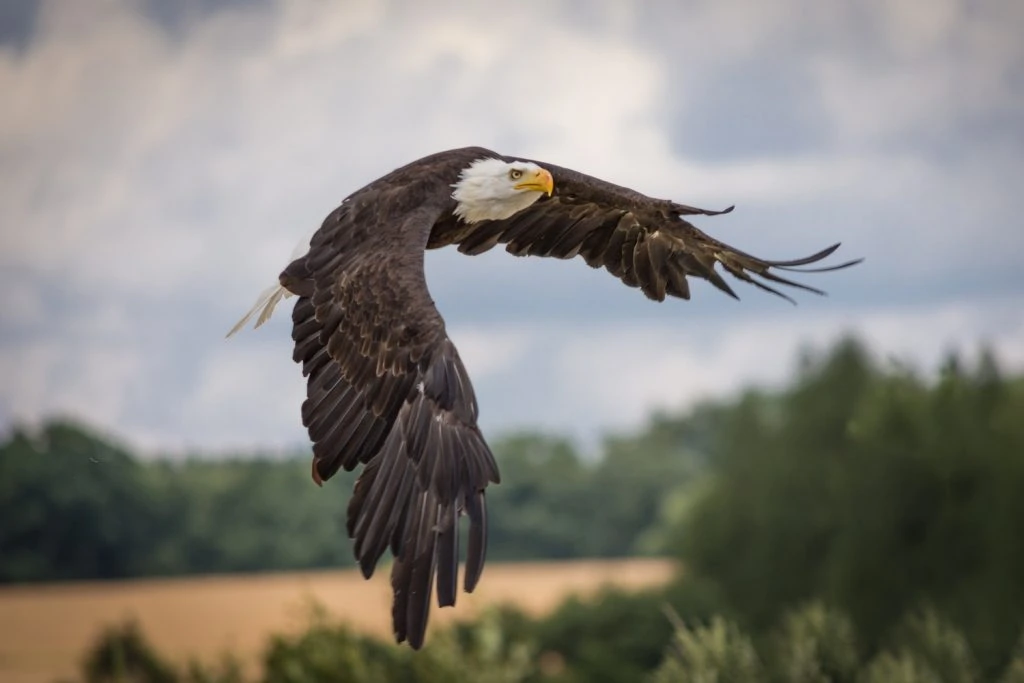
Bald Eagles can be spotted all year in Nova Scotia. They are recorded in 11% of summer checklists and 17% of winter checklists submitted by bird watchers for the province.
The Bald Eagle is a widely-recognized bird of prey. It has a white head, yellow eyes, and a large, hooked yellow bill. Its body is chocolate brown, and its legs are yellow, with huge talons.
Females look similar to males, except they’re about 25% larger. Juveniles have dark brown heads and bodies with variable white mottling or streaking until they reach their fifth year.
- Haliaeetus leucocephalus
- Length: 34 – 43 in (86 – 109 cm)
- Weight: 168 oz (4761 g)
- Wingspan: 72 – 96 in (183 – 244 cm)
Bald Eagles breed predominantly in Canada and then migrate to the United States for winter. However, some remain resident all year, especially in coastal regions.
You can find the Bald Eagle, during its breeding season, in wetland environments. Open and large bodies of water with plenty of fish are ideal spots.
When they’re nesting, roosting, or perching, Bald Eagles, need tall, mature, and large trees for good visibility and have to have an open structure allowing the Bald Eagles to see the forest floor, and must be near water, especially when nesting.
In the winter, Bald Eagles flock to spots with a lot of perches around unfrozen water with plenty of fish. When there’s no available unfrozen water source, Bald Eagles will congregate in open habitats with medium-sized mammals like in prairies and meadows.
Bald Eagles are opportunistic feeders and will eat what is available in their environment. Their favorite food is fish, and they prefer large ones, like trout and salmon. They may hunt these fish themselves or steal them away from other birds. Sometimes, they also eat carrion (dead) fish.
They also eat medium to large-sized birds, like ducks, herons, owls, and geese. During winter, bald eagles turn to mammals for their prey when fishing for food is not as lucrative. They will initially target weak, dying, or young prey. They hunt rabbits, squirrels, raccoons, beavers, and deer fawns.
Bald Eagle Calls: The squeak of the Bald Eagle does not fit its size as they make a rather disappointing high-pitched whistle!
Nests of Bald Eagles are large and sturdy to be able to withstand their size and weight. They build a stick nest, around 6 feet in diameter and 4 feet high. The male brings the materials such as sticks, grass, moss, and downy feathers, and then the female puts it all together.
Bald Eagles’ nests are considered the largest of any bird in North America.
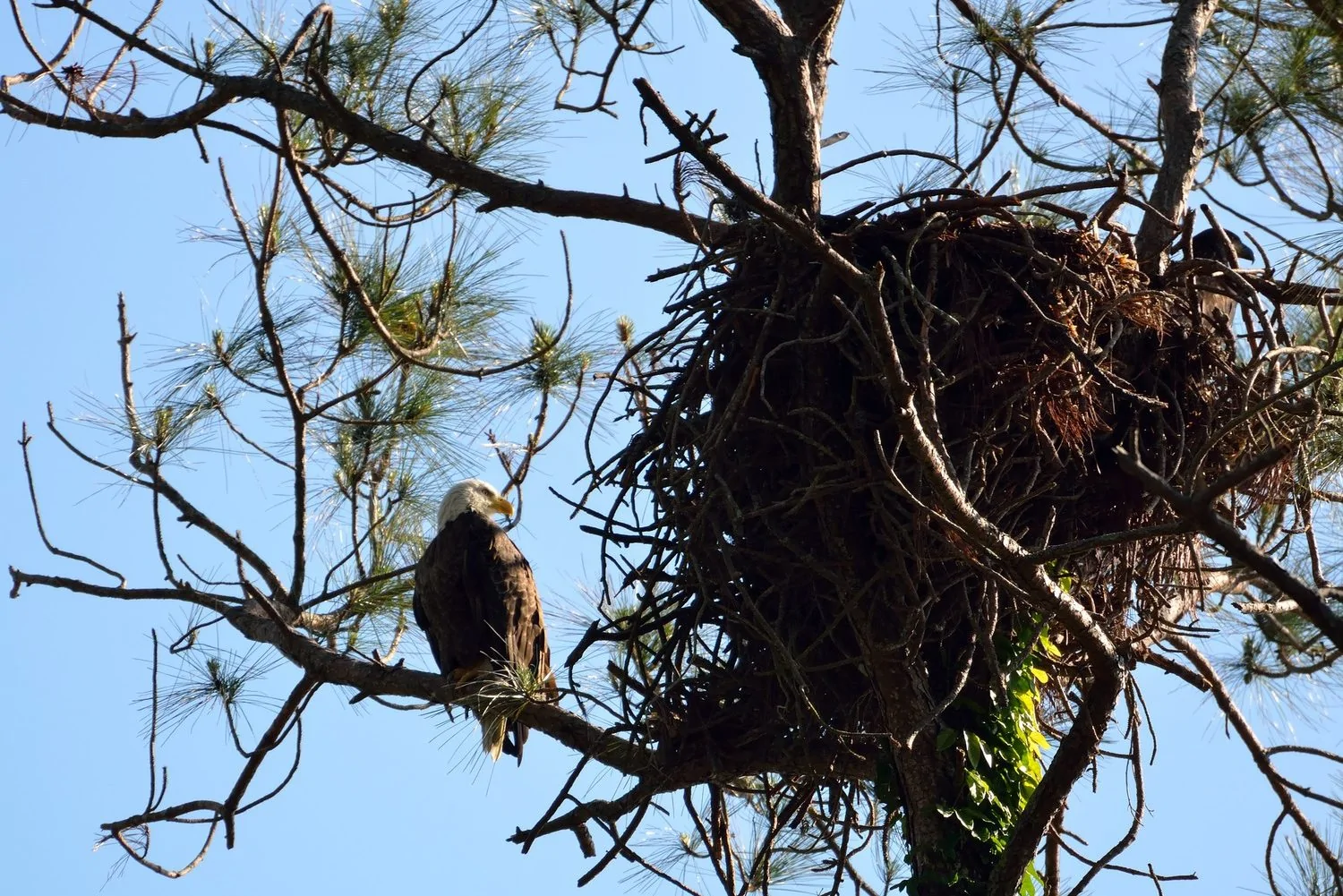
Females may lay one to three eggs per year in the wild. In captivity, they may lay up to seven eggs. The parents take turns in incubating the eggs for thirty-five days. Whoever is not sitting on the eggs gets to hunt for food to feed the other.
Fun Fact: The Bald Eagle has been the national symbol of America since 1782. It may be named “bald,” but it isn’t actually bald. The old version of “bald” actually meant “white,” referring to its white head and tail.
2. Steller’s Sea-Eagle
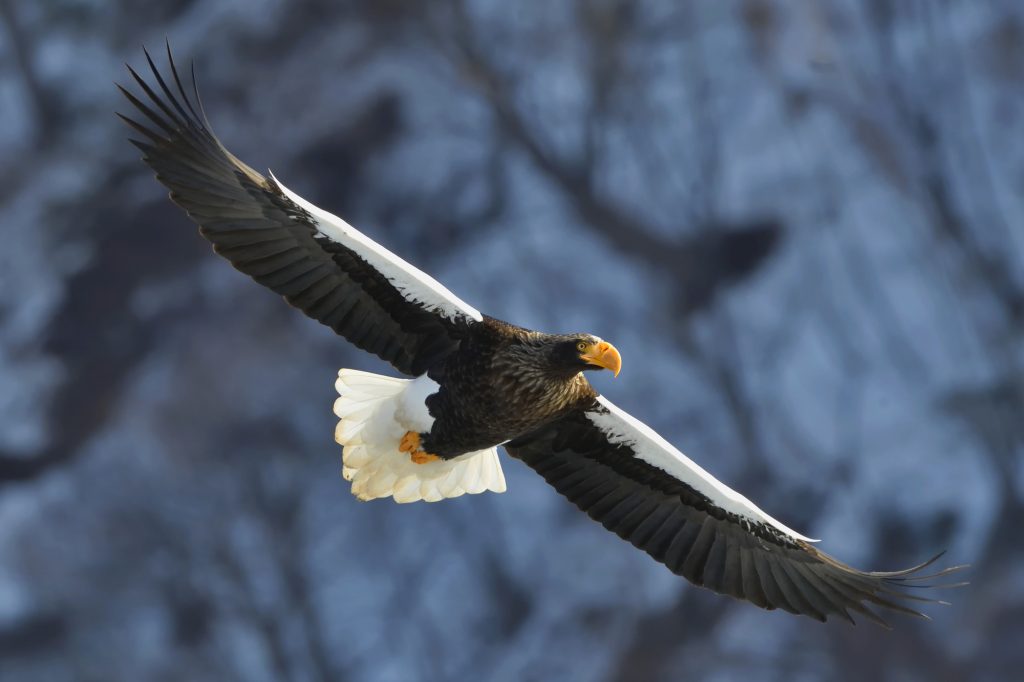
Steller’s Sea-Eagles are vulnerable species in Nova Scotia, and they are also considered accidental species in the province. However, they have recently been spotted around Wallace Bay National Wildlife Area.
Steller’s sea-eagle is the largest bird in the genus Haliaeetus and possibly the heaviest eagle in the world. Its weight ranges from 5 to 9 kilos, with females being heavier than males.
It has a white forehead, yellow eyes with a dark pupil, and a really large, yellow hooked bill. Its body is dark-brown or black with white shoulders, belly, wings, legs, and tail. Its feet are yellow with sharp talons.
Juveniles are similar to adults, but they have no white shoulders, and the end of their tails are dark. It takes around four years for them to attain the coloring of adults.
Steller’s Sea-Eagle has a very rare dark morph with black feathers everywhere except for its white tail.
- Haliaeetus pelagicus
- Length: 42 – 45 in (107 – 114 cm)
- Weight: 273.6 oz (7754 g)
- Wingspan: 86 – 98 in (218 – 249 cm)
Steller’s Sea-Eagles are usually found in the rocky seacoasts and rivers of northeastern Siberia in Russia. They migrate to Korea, Japan, and China during winter, staying in coastal areas and on lakes near the coast. However, they occasionally wander into North America.
Steller’s Sea-Eagles love fish, particularly river fish like salmon and trout, which they hunt in shallow water. They also consume salmon that die after spawning because these are more abundant and available in areas with unfrozen water in autumn.
In other areas, they may also hunt and feed on water birds like ducks, geese, swans, and cranes. Mammals are also part of their diet. They favor the American mink, Arctic fox, red fox, and small domestic dogs.
Steller’s Sea Eagle Calls:
Nests of Steller’s Sea Eagle, or as they’re called “aeries,” are built on tops of trees or on rocky outcrops, as high as 100 feet above the ground. While they’re high, they’re still close to the water so that they have easy access to food from their nests.
Steller’s Sea-Eagles build massive nests out of sticks and branches. Since they tend to re-use these nests, they keep adding more sticks and branches to them to keep them sturdy and strong.
The female lays one to three eggs in their chosen nest. Incubation lasts as long as forty-five days. When the chicks hatch, they need all the protection they can get, as it takes about a couple of months or so for them to fly.
Steller’s Sea-Eagles are considered “Vulnerable” due to threats of habitat destruction, industrial pollution, and over-fishing.
Fun Fact: Steller’s Sea Eagles sometimes build a second alternate nest in the event that the first one becomes so heavy that the branches it’s sitting on can’t carry the weight and break.
3. Golden Eagle
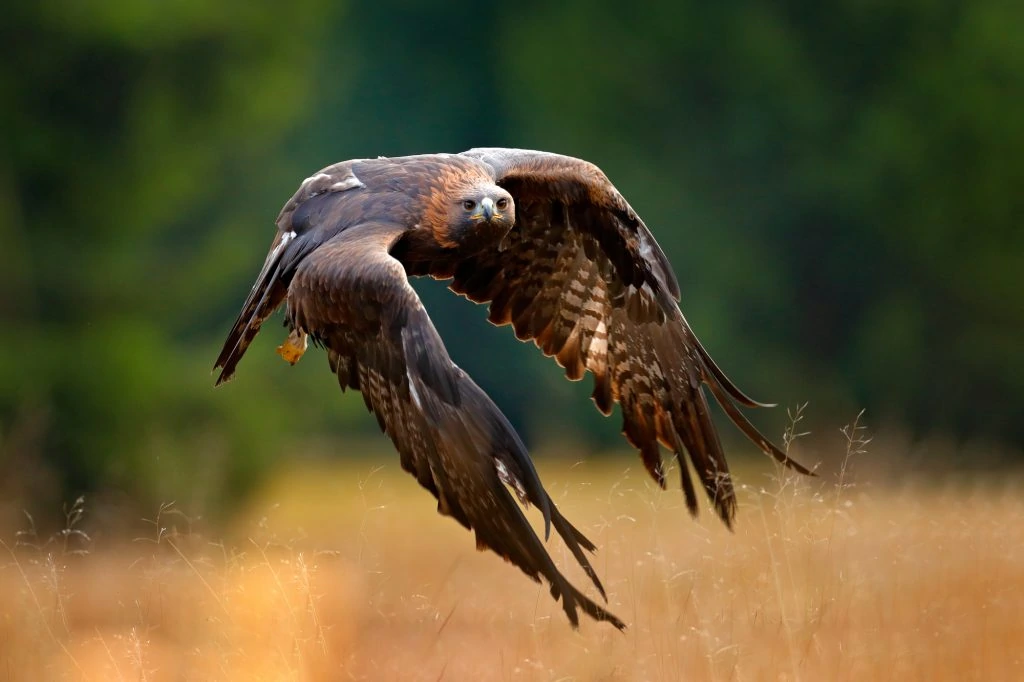
Golden Eagles are rare or accidental species in Nova Scotia, but there have been a couple of sightings here. They have been spotted around Kings back.
Golden Eagles are the most widely distributed eagles in the world. Their crown and nape (neck) are golden-brown and are a sight to behold when in the right light.
Their bodies are darker brown but with pale flight feathers. Their eyes vary from light yellow to dark brown. They have a yellow cere, which is the skin on the beak which attaches to the forehead, and their bill is dark at the tip.
While adults look similar, females are larger than males. Juveniles are also similar, but they tend to have a darker color, sometimes appearing black on the back. They also have white patches on the underside of their wings and some white coloring on the tail.
The Golden Eagle has six subspecies: European Golden Eagle, Iberian Golden Eagle, Asian Golden Eagle, Japanese Golden Eagle, North American Golden Eagle, and the Kamchatkan Golden Eagle. Their differences lie in their size and the slight variations in the color of their feathers.
- Aquila chrysaetos
- Length: 27 – 38 in (69 – 97 cm)
- Weight: 160 oz (4534 g)
- Wingspan: 72 – 96 in (183 – 244 cm)
Golden Eagles that breed in Canada and Alaska migrate south for winter to the United States and northern Mexico. However, Golden Eagles in western US states remain all year.
You can find Golden Eagles in mountainous habitats far above the treelines. They also inhabit canyons, riverside cliffs, and bluffs when nesting. They generally prefer to avoid human presence.
If you want to get a birds-eye view of a Golden Eagles’ day, then check out the video below, but only if you’re not scared of heights!
Since Golden Eagles are birds of prey, naturally, they’d prey on small to medium-sized animals like rabbits, prairie dogs, and hares. On occasion, they may also hunt and take down larger prey like cranes, swans, and domestic livestock. They usually hunt in pairs, with one chasing down the prey until it gets tired, and then the other swoops in for the kill.
Golden Eagle Call: The main calls that are made by Golden Eagles are during the breeding season when chicks are begging, and parents respond. Otherwise, they are pretty quiet. They make high-pitched whistled calls.
Nests of Golden Eagles are usually located at high elevations, like cliffs. However, they also build them in trees or artificial structures like observation towers, nesting platforms, and even windmills. They’re built high so the parents can have a wide view over their nesting and hunting grounds.
Golden Eagle nests take anywhere from one to three months to build out of sticks and plant material.
They even line their nests with aromatic leaves to keep the insects and other pests at bay. These nests are re-used for many years and grow in size as the adults continue to add material to them.
The female lays one to three eggs, and the parents take turns in incubating the eggs from forty-one to forty-five days. The chick hatches from its egg in 37 hours.
Fun Fact: The Golden Eagle, the Rough-legged Hawk, and the Ferruginous Hawk are the only American birds of prey that have feathers on their legs up to their toes.

